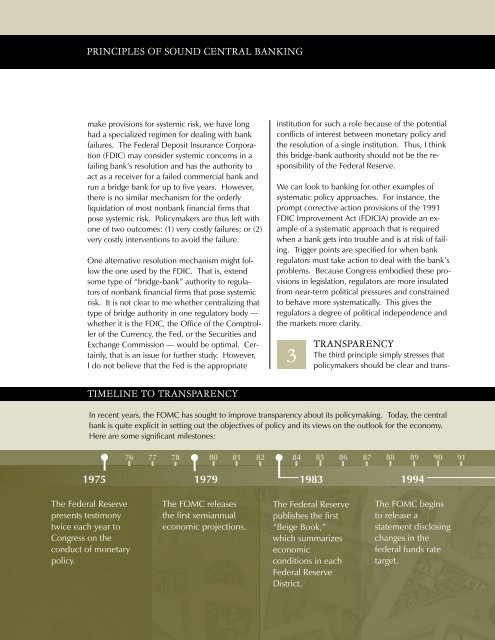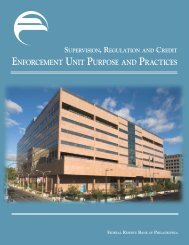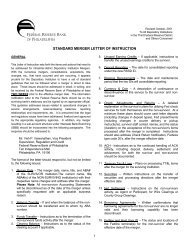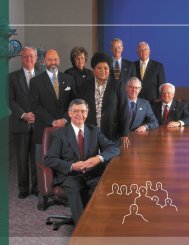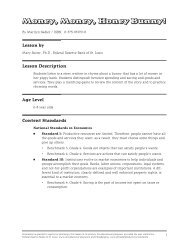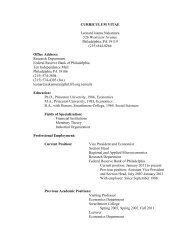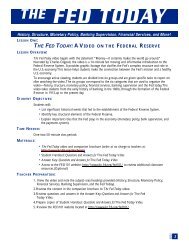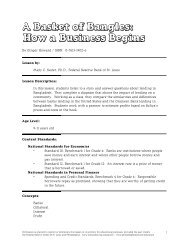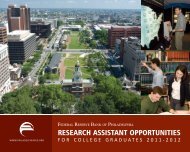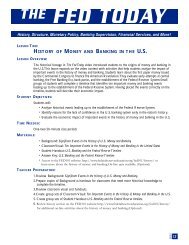Complete 2008 Annual Report - Federal Reserve Bank of Philadelphia
Complete 2008 Annual Report - Federal Reserve Bank of Philadelphia
Complete 2008 Annual Report - Federal Reserve Bank of Philadelphia
Create successful ePaper yourself
Turn your PDF publications into a flip-book with our unique Google optimized e-Paper software.
Principles <strong>of</strong> Sound Central <strong>Bank</strong>ing<br />
make provisions for systemic risk, we have long<br />
had a specialized regimen for dealing with bank<br />
failures. The <strong>Federal</strong> Deposit Insurance Corporation<br />
(FDIC) may consider systemic concerns in a<br />
failing bank’s resolution and has the authority to<br />
act as a receiver for a failed commercial bank and<br />
run a bridge bank for up to five years. However,<br />
there is no similar mechanism for the orderly<br />
liquidation <strong>of</strong> most nonbank financial firms that<br />
pose systemic risk. Policymakers are thus left with<br />
one <strong>of</strong> two outcomes: (1) very costly failures; or (2)<br />
very costly interventions to avoid the failure.<br />
One alternative resolution mechanism might follow<br />
the one used by the FDIC. That is, extend<br />
some type <strong>of</strong> “bridge-bank” authority to regulators<br />
<strong>of</strong> nonbank financial firms that pose systemic<br />
risk. It is not clear to me whether centralizing that<br />
type <strong>of</strong> bridge authority in one regulatory body —<br />
whether it is the FDIC, the Office <strong>of</strong> the Comptroller<br />
<strong>of</strong> the Currency, the Fed, or the Securities and<br />
Exchange Commission — would be optimal. Certainly,<br />
that is an issue for further study. However,<br />
I do not believe that the Fed is the appropriate<br />
institution for such a role because <strong>of</strong> the potential<br />
conflicts <strong>of</strong> interest between monetary policy and<br />
the resolution <strong>of</strong> a single institution. Thus, I think<br />
this bridge-bank authority should not be the responsibility<br />
<strong>of</strong> the <strong>Federal</strong> <strong>Reserve</strong>.<br />
We can look to banking for other examples <strong>of</strong><br />
systematic policy approaches. For instance, the<br />
prompt corrective action provisions <strong>of</strong> the 1991<br />
FDIC Improvement Act (FDICIA) provide an example<br />
<strong>of</strong> a systematic approach that is required<br />
when a bank gets into trouble and is at risk <strong>of</strong> failing.<br />
Trigger points are specified for when bank<br />
regulators must take action to deal with the bank’s<br />
problems. Because Congress embodied these provisions<br />
in legislation, regulators are more insulated<br />
from near-term political pressures and constrained<br />
to behave more systematically. This gives the<br />
regulators a degree <strong>of</strong> political independence and<br />
the markets more clarity.<br />
3<br />
Transparency<br />
The third principle simply stresses that<br />
policymakers should be clear and trans-<br />
Timeline to Transparency<br />
In recent years, the FOMC has sought to improve transparency about its policymaking. Today, the central<br />
bank is quite explicit in setting out the objectives <strong>of</strong> policy and its views on the outlook for the economy.<br />
Here are some significant milestones:<br />
76 77 78 80 81 82 84 85 86 87 88 89<br />
1975 1979 1983 1994<br />
90<br />
91<br />
The <strong>Federal</strong> <strong>Reserve</strong><br />
presents testimony<br />
twice each year to<br />
Congress on the<br />
conduct <strong>of</strong> monetary<br />
policy.<br />
The FOMC releases<br />
the first semiannual<br />
economic projections.<br />
The <strong>Federal</strong> <strong>Reserve</strong><br />
publishes the first<br />
“Beige Book,”<br />
which summarizes<br />
economic<br />
conditions in each<br />
<strong>Federal</strong> <strong>Reserve</strong><br />
District.<br />
The FOMC begins<br />
to release a<br />
statement disclosing<br />
changes in the<br />
federal funds rate<br />
target.


